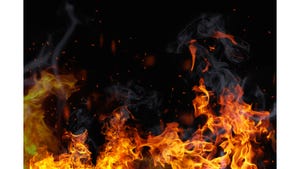Safely Collecting Combustible Metal Dusts
July 31, 2009
 Many common powders can be explosive when mixed with air in the right proportions. Much has been written about the subject, and we’ve all seen MacGyver do it on TV. Divide a combustible dust finely enough, enclose it, mix it with air in the proper ratio, and give it a source of ignition. In general, anything with calories, or anything that will burn, can also explode given the right conditions. Fortunately, most engineers know about the hazards of collecting wood, coal, plastic, and sugar dust, as well as starches and other food products. Based on the recent push by OSHA, most new dust collection systems are designed according to NFPA standards. What many designers don’t realize is how powerful a metal dust explosion can be, and how the safety requirements differ from a typical dust collection system.
Many common powders can be explosive when mixed with air in the right proportions. Much has been written about the subject, and we’ve all seen MacGyver do it on TV. Divide a combustible dust finely enough, enclose it, mix it with air in the proper ratio, and give it a source of ignition. In general, anything with calories, or anything that will burn, can also explode given the right conditions. Fortunately, most engineers know about the hazards of collecting wood, coal, plastic, and sugar dust, as well as starches and other food products. Based on the recent push by OSHA, most new dust collection systems are designed according to NFPA standards. What many designers don’t realize is how powerful a metal dust explosion can be, and how the safety requirements differ from a typical dust collection system.
In general, combustible metals are more prone to ignition and produce a faster burn, with higher peak pressures than the other combustible dusts. Resulting deflagrations and explosions can be much more violent and special precautions must be taken. When you were a kid, did you ever unwrap a firecracker? Remember that silver powder? That was aluminum mixed with an oxidizer. Now, just imagine a dust collector full of that material.
Aluminum, magnesium, and titanium are by far the most common combustible metals. Also, other less-common elements, plus limitless alloys, can be combustible. NFPA 484 is the standard used for handling combustible metals, and those accustomed to following NFPA 654 will have to relearn a few things when designing a dust collection system for these materials. The protective measures recommended in NFPA 654 are not sufficient. NFPA 484 includes separate sections dedicated to each of the major combustible metals. For the purposes of this column, we will briefly review the first three.
Aluminum may be collected using wet dust collectors located indoors, near the point of dust generation. Dry collectors are also permitted, as long as the system is located outdoors and fitted with deflagration vents. Recycling exhaust air is not permitted with dry systems but is allowed for wet collectors under most circumstances. Ductwork must be properly grounded and duct velocity must be held above 4500 ft/min. Collected solids must be removed daily.
Titanium is treated much like aluminum, except that media collectors are forbidden. Dry cyclones are permitted outdoors, but dust storage must not exceed five gallons. Cyclones must be equipped with sparkproof blowers.
Magnesium is treated in a similar manner to titanium, with minor changes. Ductwork velocity may be as low as 3500 ft/min. Dry cyclones must be water-tight; wet collectors must have positive (motorized) sump ventilation. Dust concentration must not exceed 25% of minimum explosible concentration (MEC) in ductwork. Wet collectors are limited to 5 g/cu ft inlet loading.
There are also several important guidelines that are common to all combustible metals. First, do not mix metals in the same dust collector. Some mixtures produce a thermite reaction (the material burns exothermically without air). Other mixtures produce unpredictable results (excessive hydrogen formation, heat, etc.). Dust collectors must be cleaned out before introducing a new metal.
Avoid contact between dry powder and water to prevent possible spontaneous heating and hydrogen generation. These materials pull oxygen away from water and liberate hydrogen. Pay particular attention to sources of ignition. These metals can have a very low minimum ignition energy (MIE). Static electricity must be addressed through proper bonding and grounding, and moving parts must not produce sparks or excessive heat.
Consider conducting an explosibility study to obtain accurate information on the properties of your material. One problem with combustible metals is the speed of the burn. Every powder is a little different, and in many cases a standard explosion vent simply can’t open fast enough. Testing will help with the design of explosion vents.
In summary, do your homework. Be smart, be safe, and have a plan. Obtain a copy of NFPA 484 and read it. A thorough understanding of the risks is essential to designing a safe and effective dust collection system. Combustible metal dust is different from other powders and must be treated with extra caution.
Rick Wynn is the vice president of Wynn Environmental Sales (Warwick, PA). He has a degree in mechanical engineering from the University of Pittsburgh and holds a U.S. patent for a wet dust collection system.
You May Also Like


